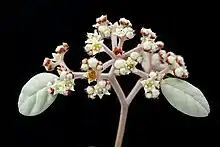| Spyridium spadiceum | |
|---|---|
 | |
| In the Australian National Botanic Gardens | |
| Scientific classification | |
| Kingdom: | Plantae |
| Clade: | Tracheophytes |
| Clade: | Angiosperms |
| Clade: | Eudicots |
| Clade: | Rosids |
| Order: | Rosales |
| Family: | Rhamnaceae |
| Genus: | Spyridium |
| Species: | S. spadiceum |
| Binomial name | |
| Spyridium spadiceum | |
| Synonyms[1] | |
Spyridium spadiceum is a species of flowering plant in the family Rhamnaceae and is endemic to the south of Western Australia. It is an erect or semi-prostrate shrub with narrowly oblong to oval leaves and heads of hairy flowers with brown bracts at the base.
Description
Spyridium spadiceum is an erect slender, or weak semi-prostrate shrub that typically grows to a height of 0.15–3 m (5.9 in – 9 ft 10.1 in), its branches covered with soft, sometimes rust-coloured hairs. The leaves are narrowly oblong to oval, 1–3 mm (0.039–0.118 in) long, softly-hairy on the upper surface and white on the lower side, the veins sometimes covered with rust-coloured hairs. The flowers heads are arranged in cymes with many broad, brown bracts at the base. The sepal tube is about 2 mm (0.079 in) long and densely hairy.[2][3]
Taxonomy
This species was first formally described in 1837 by Eduard Fenzl who gave it the name Trymalium spadiceum in Enumeratio plantarum quas in Novae Hollandiae ora austro-occidentali ad fluvium Cygnorum et in sinu Regis Georgii collegit Carolus Liber Baro de Hügel.[4][5] In 1863, George Bentham changed the name to Spyridium spadiceum in Flora Australiensis.[6] The specific epithet (spadiceum) means "brown" or "date-coloured", referring to the floral bracts.[7]
Distribution and habitat
Spyridium spadiceum grows on granitic hills in the Porongurup Range and at Albany in the Jarrah Forest bioregion in the south of Western Australia.[3][8]
Conservation status
Spyridium spadiceum is listed as "Priority Four" by the Government of Western Australia Department of Biodiversity, Conservation and Attractions,[3] meaning that it is rare or near threatened.[9]
References
- 1 2 "Spyridium spadiceum". Australian Plant Census. Retrieved 6 November 2022.
- ↑ Bentham, George; von Mueller, Ferdinand (1863). Flora Australiensis. Vol. 1. London: Lovell Reeve & Co. p. 428. Retrieved 6 November 2022.
- 1 2 3 "Spyridium spadiceum". FloraBase. Western Australian Government Department of Biodiversity, Conservation and Attractions.
- ↑ "Trymalium spadiceum". Australian Plant Name Index. Retrieved 6 November 2022.
- ↑ Endlicher, Stephan (1837). Endlicher, Stephan; Fenzl, Eduard; Bentham, George; Schott, Heinrich Wilhelm (eds.). Enumeratio plantarum quas in Novae Hollandiae ora austro-occidentali ad fluvium Cygnorum et in Sinu Regis Georgii collegit Carolus liber baro de Hügel. p. 26. Retrieved 6 November 2022.
- ↑ "Spyridium spadiceum". Australian Plant Name Index. Retrieved 6 November 2022.
- ↑ Sharr, Francis Aubi; George, Alex (2019). Western Australian Plant Names and Their Meanings (3rd ed.). Kardinya, WA: Four Gables Press. p. 309. ISBN 9780958034180.
- ↑ Rye, Barbara L. (1996). "A synopsis of the genera Pomaderris, Siegfriedia, Spyridium and Trymalium (Rhamnaceae) in Western Australia". Nuytsia. 11 (1): 124. Retrieved 6 November 2022.
- ↑ "Conservation codes for Western Australian Flora and Fauna" (PDF). Government of Western Australia Department of Parks and Wildlife. Retrieved 6 November 2022.
